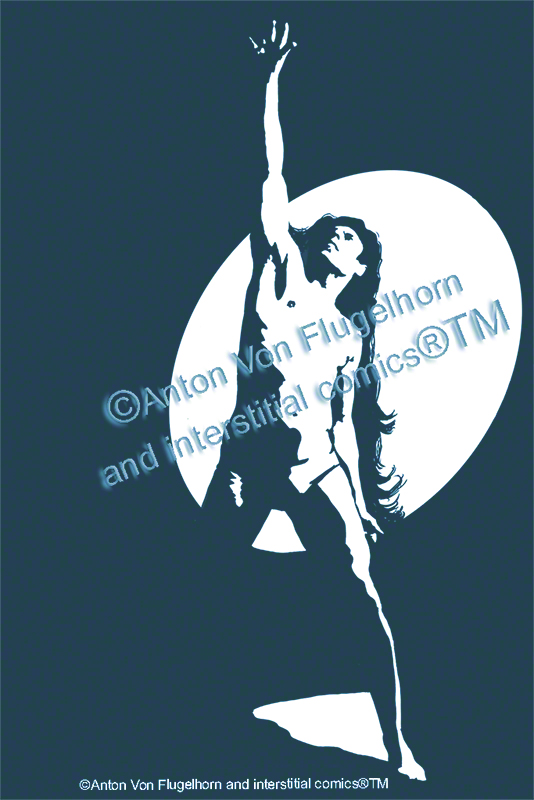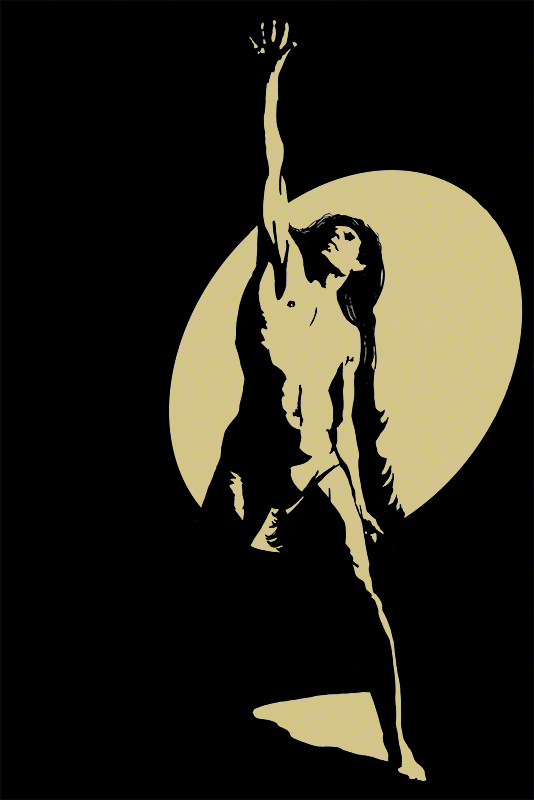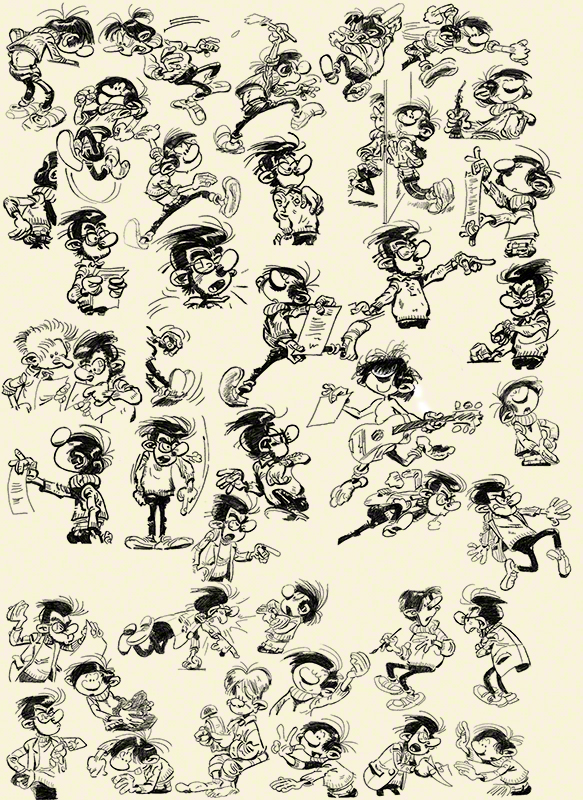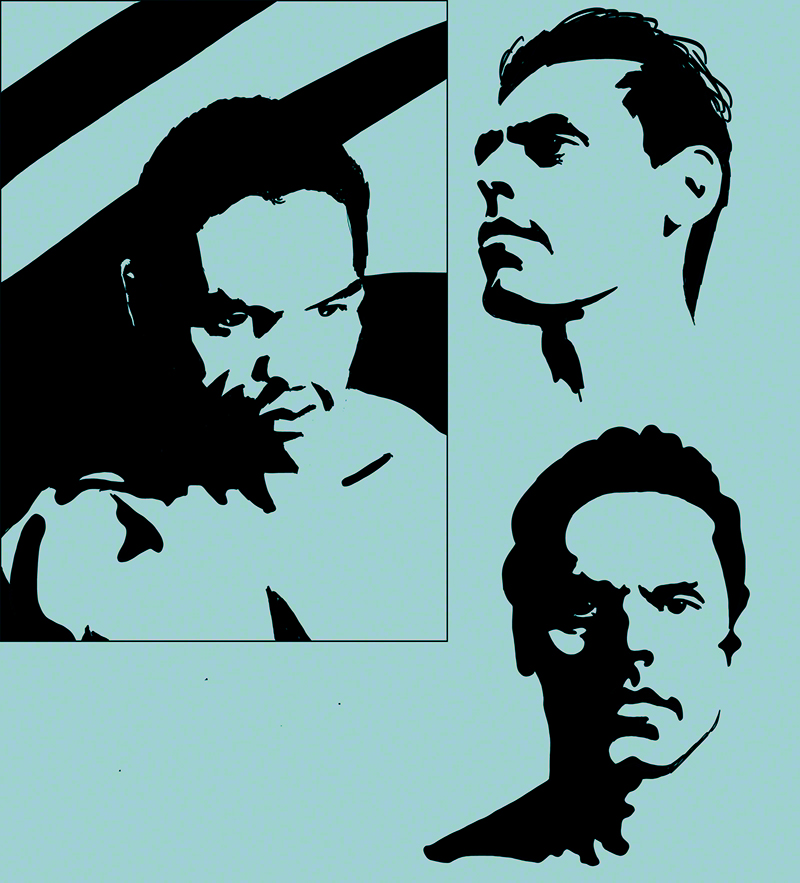I’m going on vacation so here are the entries for week 9 and 10, if you want info about joining the class look at the end of this post.
week9 This is it: A full body pose in a head class! I have been working like crazy on this style (full black or full white) for a while now, and it’s very time-consuming but I’m begining to be happy about what I’m doing.
And guess what: so is Glenn Vilppu! Wooah ! (insert snoopy dance animation here).
So for a change here is the drawing I made. Apologies for the tinge (digimark problem again) and for the © notice across it, but I have my reasons you’ll see if you read on.

The first thing Glenn told me in the crit is that he’s amazed at the difference between this style and the style I’m using on my comics. I am indeed doing another class than “head drawing” with him, that is the special personal project class, in which I work on my comicbook. I dont show it to you because it’s not ready. The style of it is very European comics, somewhere between Asterix and something totally crazy. Indeed, the total opposite of the drawing you see here above. I plan to use my black and white style in a comic too (another comic, obviously) and on design works (hence the © now that I’m getting somewhere – by the way if some of you are interested in knowing how to trademark something let me know – you can add TM to anything that is yours, but (R) is only for what has been legally registered, a long process, don’t use (r) next to something without first registering and getting your (r) certificate, using (r) without the proper legal work can end you in jail!).
Glenn went on “nitpicking” as he said about small details, and here we are entering into the real work, the work a designer will spend hours and days on, and that Glenn advises me to spend the next week on).
My model’s body goes up on the left and rather down on the other side – I can – believe it or not, (I did not until Glenn did a demo to show it’s possible) accentuate that. First: the hair, it’s falling rather meaninglessly (like real hair in real life, which is not what I’m representing here) could expand, or even contradict the movements. The light on the left leg, too complex, is not descriptive enough. Same thing for the ribs (that, considering the position, will stick out – if you cant guess where, review your anatomy at once!). The stomach area could also be made to show move movement or more 3D.
‘Cause the trick here is: you can see it’s a guy lifting his arm up, so it’s 3D, but at the same time it’s just very defined black spots, which are 2D. The “spots” characteristic is great for reproduction, you can easily use it on posters t-shirts, tags, you name it. And as I’m beginning to produce here something that is “saleable” I’m protecting myself and I’m a lucky artist: like the big majors I have a copyright lawyer working for me (if needed) all year round (a family member who likes me a lot). I confess it’s comfortable to know that, with my copyright and registered trademark and my lawyer I can attack, free of charge for me, any thief or self-styled “borrower” in any country. Now, I’m not saying: marry a copyright lawyer or push your sister to get married with one, but…. well, lawyers are not all bad (as the dino who ate one in Jurassic Park proved – thanks Weird Al for this joke). But what I’m saying is: protect your work! Legally, but only through a government site, dont use a go-between site, you can register and trademark things yourself as long as you have a brain and a cup of coffee. (pet peeves alert) AND if you work digitally or if you scan your work (you must!!!) make *remote* backups on dropbox or other (remote because if your house burns the original and the scan are both gone and you’ll feel like a fool). Yes, I know, dropbox is said to be visited by the CIA, but I doubt their bots are programmed to steal art! lol. You can also send a copy of your work to a trustworthy friend who will keep it in his/her archive (and you can do the same for him/her). Or leave a hard disk with your scans on it at you mamma’s place, she’ll be happy to help and wont have any idea how to try and look at what’s on the hard drive, so even if you do erotica you are safe!
I’m going to spend the final week of this head class working of details of this full body pose. I’m also going to continue working on this style next semester and on my cartoony comics. After all, no one says you should have only one style. Moebius (The Incal) and Jean Giraud (Blueberry, etc.) were two totally different artists, yet they were…. the same person!
Draw in any style, but draw and be daring! Explore new ways of drawing!
now week ten!:
Week ten – Hair (not the musical)
Week ten – Hair (not the musical). I would have loved to start this last entry of the head class blog with a quote from a song from Hair, but I just realized I’ve never seen that musical – or the movie, “let the sun shine in”… is that in Hair?
In any case, this is the last week of my taking for the fifth time the head class with Glenn Vilppu.
I really obsessed a lot this time on my black – white – no-grey style, but as it’s totally entwined with an understanding (or not in case of failure) of the planes of the head, it’s been hard work and I’m very happy with all I have learned.
Last week I drew a head to foot Tarzan-like fellow (to test on the rest of the body my new style in the works as ordered by Glenn).
It was ok but there was some improvements to make. I did rework it, and here is the result:

First, let me tell you that I positively HATE that hair! I love the idea of this guy having super long hair (doesn’t make any sense for Tarzan or Conan to have super-long hair, but who cares?). But the rework of it here is…. awful in my opinion.
At first I had added long hair only to separate the light from the white of the arm on the right. But thinking about it, he should have some unkempt hair, and some hair dangling between his legs (which is totally ridiculous in my drawing here!! thanks for not commenting on that :-D)
I was at a loss, but as usual Glenn found the solution in one second: wind! (well *I* call it like that), mass and movement!
If the hair is taking more space on the right instead of dropping dead right down, it looks more alive (pun), the hair between the legs is not useful, just add some hair on the left side on the body, just a lock, our brain will get that, of course, this guy’s hair is all around his back!
Glenn even suggested that I try making the white ellipse around the body smaller, so some of the arm on the right side (our right side) will have lost edges – like the arm pointing forward, since that leaves me more choice as to what to do with the hair..
Obvious, simple, easy solution… when you have been an artist and a teacher for 50 years! Well, I haven’t, and I saw nothing of this solution before Glenn spoke! I was totally blocked, angry at myself because it looked “somehow wrong”, I sent it anyway with a note saying “I hate that hair!” and bingo, he told me what to do – the advantage of having a Master’s feedback.
The next set of courses starts on the fourth of January, so if you want to join me/us (a happy bunch of happy, fast-progressing artists) go to vilppuacademy.com and sign up (yes there are payement facilities for penniless artists like you, me, and everyone else).
The fourth of January, I shall take figure one for the fifth time – still with a black and white approach – and an accent on the female body, which is so difficult for me, and also the mentoring class on my comic book (going very nicely, thanks).
Until then, I’m going to go for a change, cause a change is as good as a rest: I’m going to do something I’ve never ever done before: painting landscapes! In digital (the advantage of having a Wacom Companion is you can go around in the countryside with it) well…. in truth, digital cause I’ll be staying at my in-laws’s house and if they find out I brought a tube of oil paint (even water-based) in the house they are going to kill me! In any case, what I want to study is atmospheric influence on colors, distances in colors, it’s the same in paint or digital, though in one case you press tubes, go crazy, whereas in the other case you play around with the color wheel, crash Windows, go crazy and start all over again. No big difference if you ask me.
See you in January then, see you next year in fact, and so Happy Whatever to you! Please remplace “Whatever” by the name of what your are celebrating this season, if your dont celebrate anything replace by “vacations”!
Best wishes to you all, and sketch a lot during the break !
Cheers,
Anton











